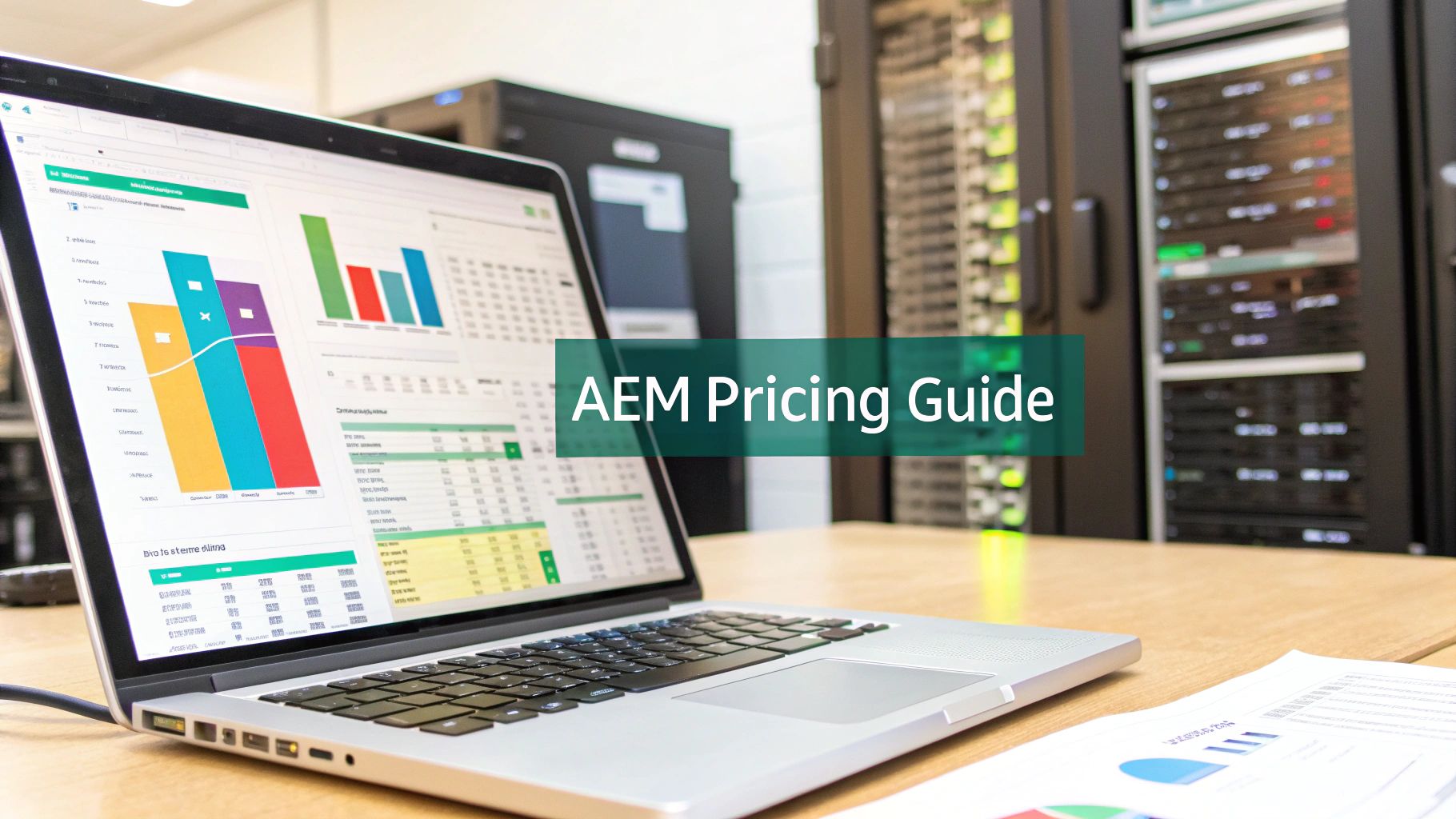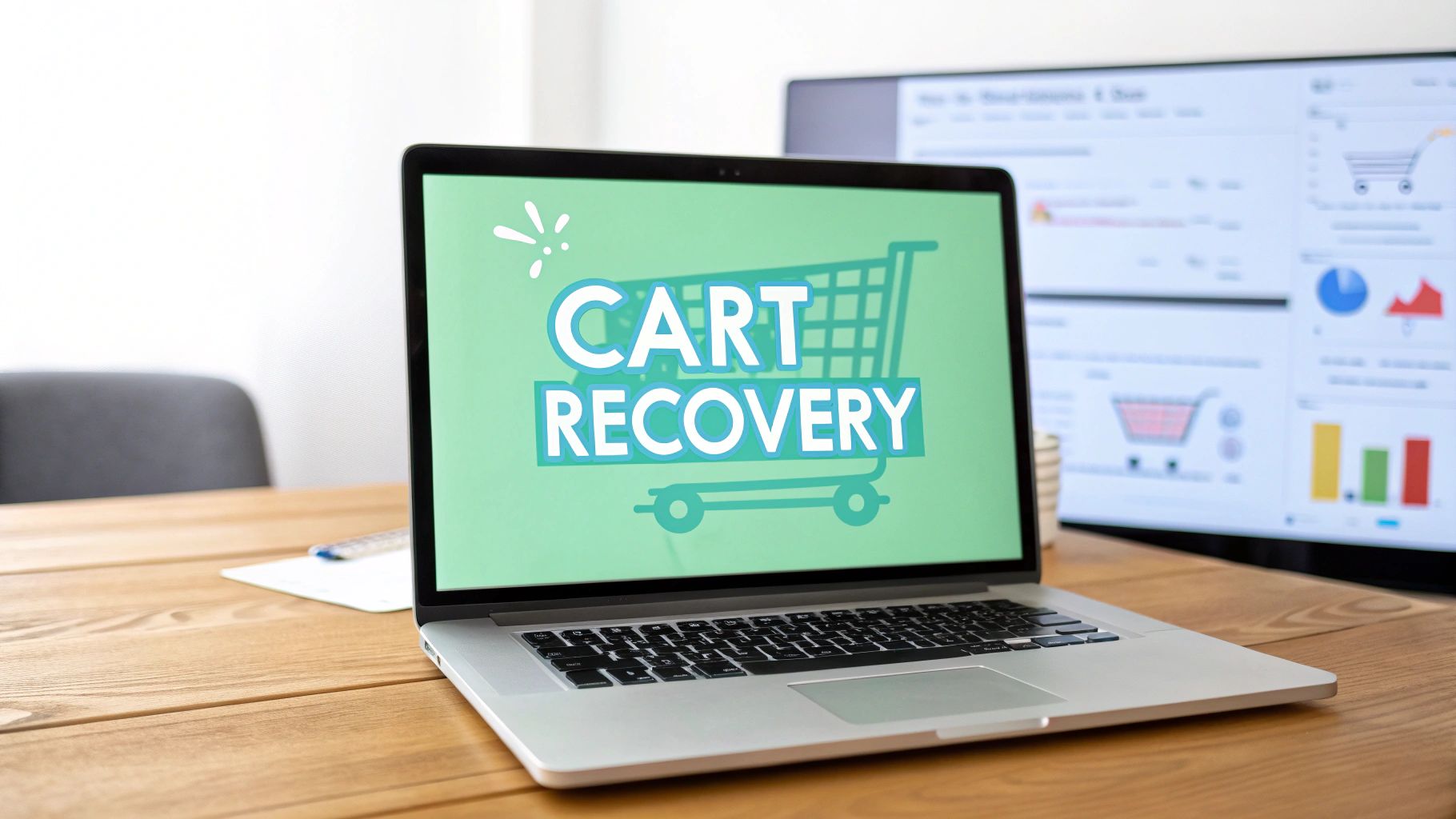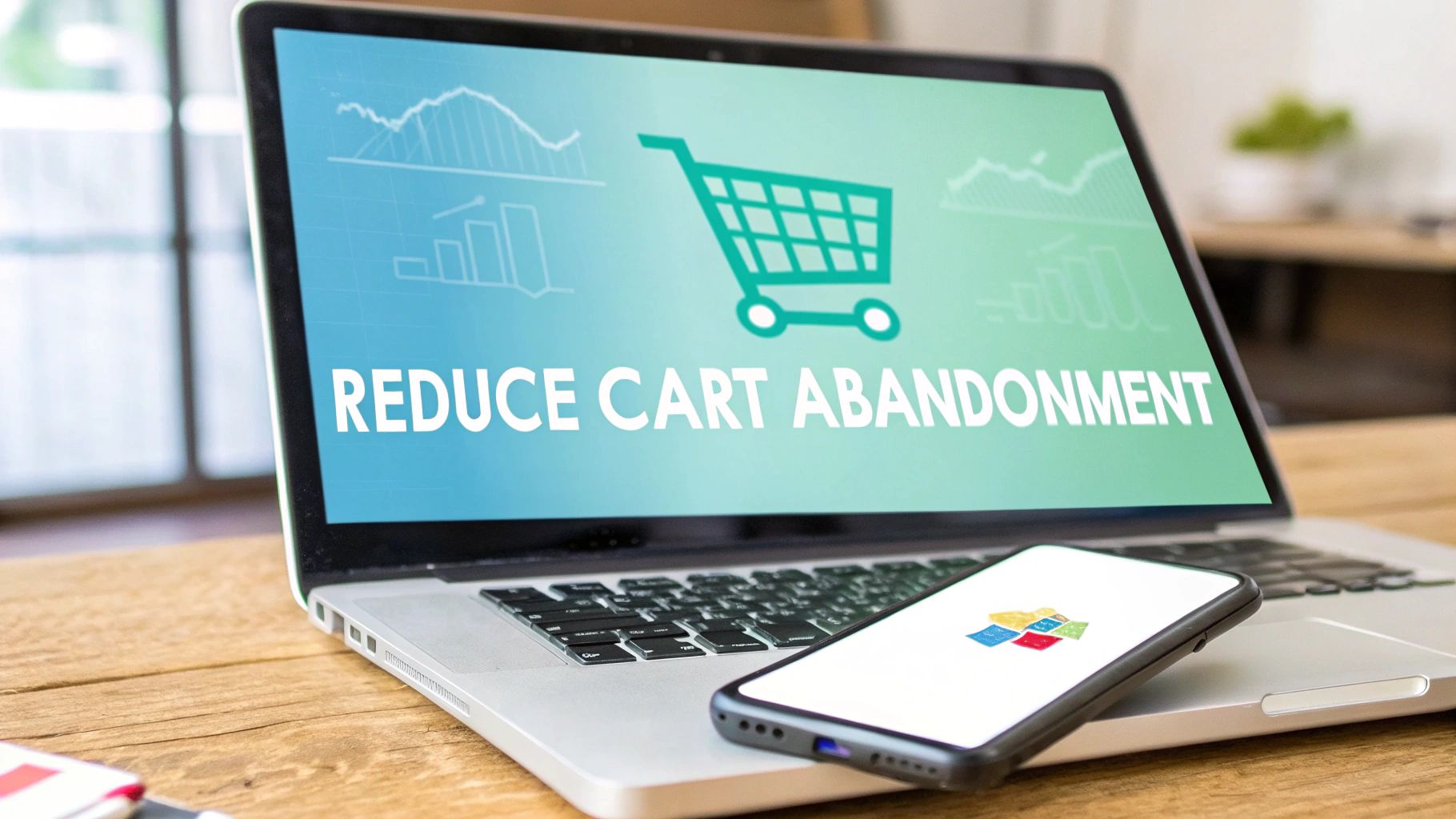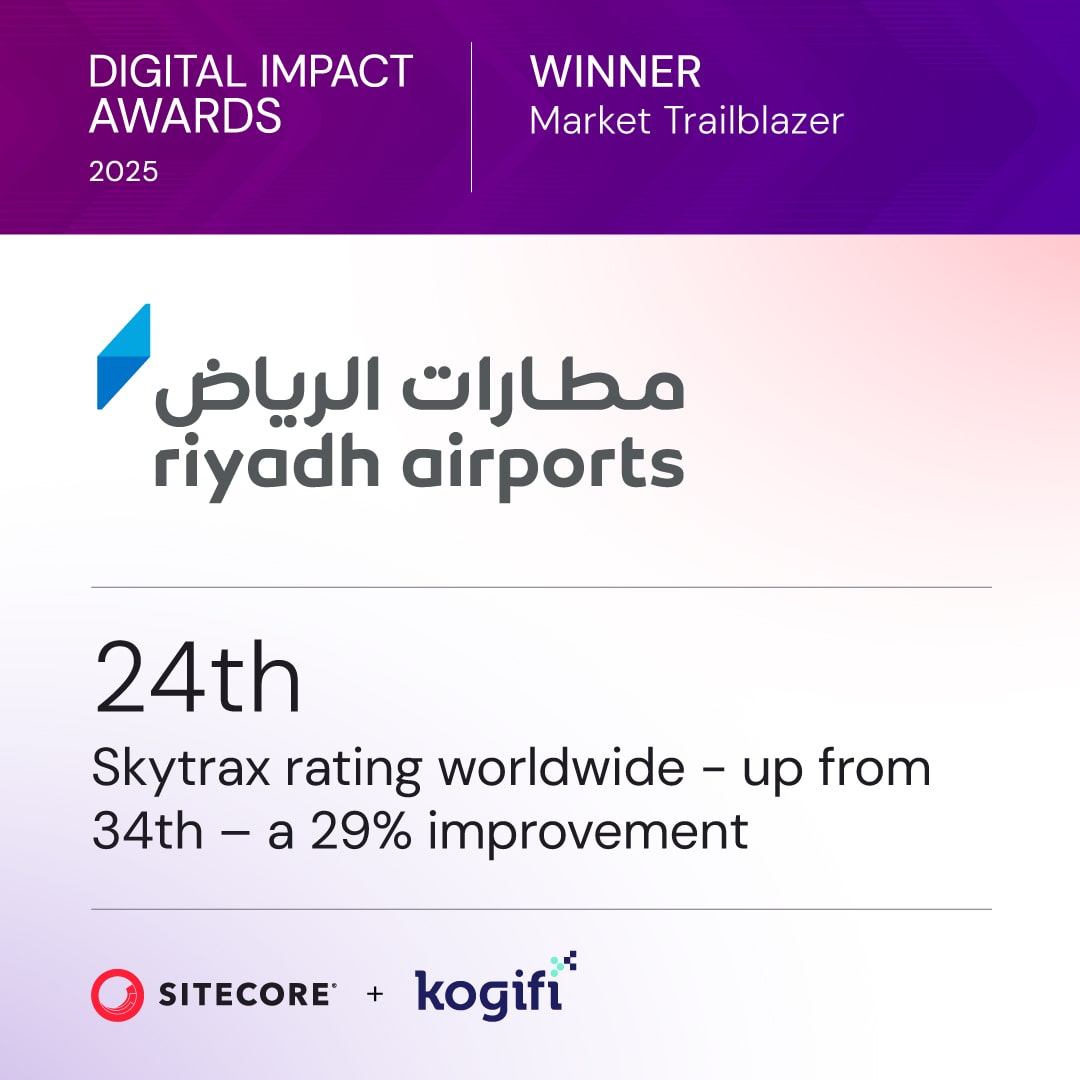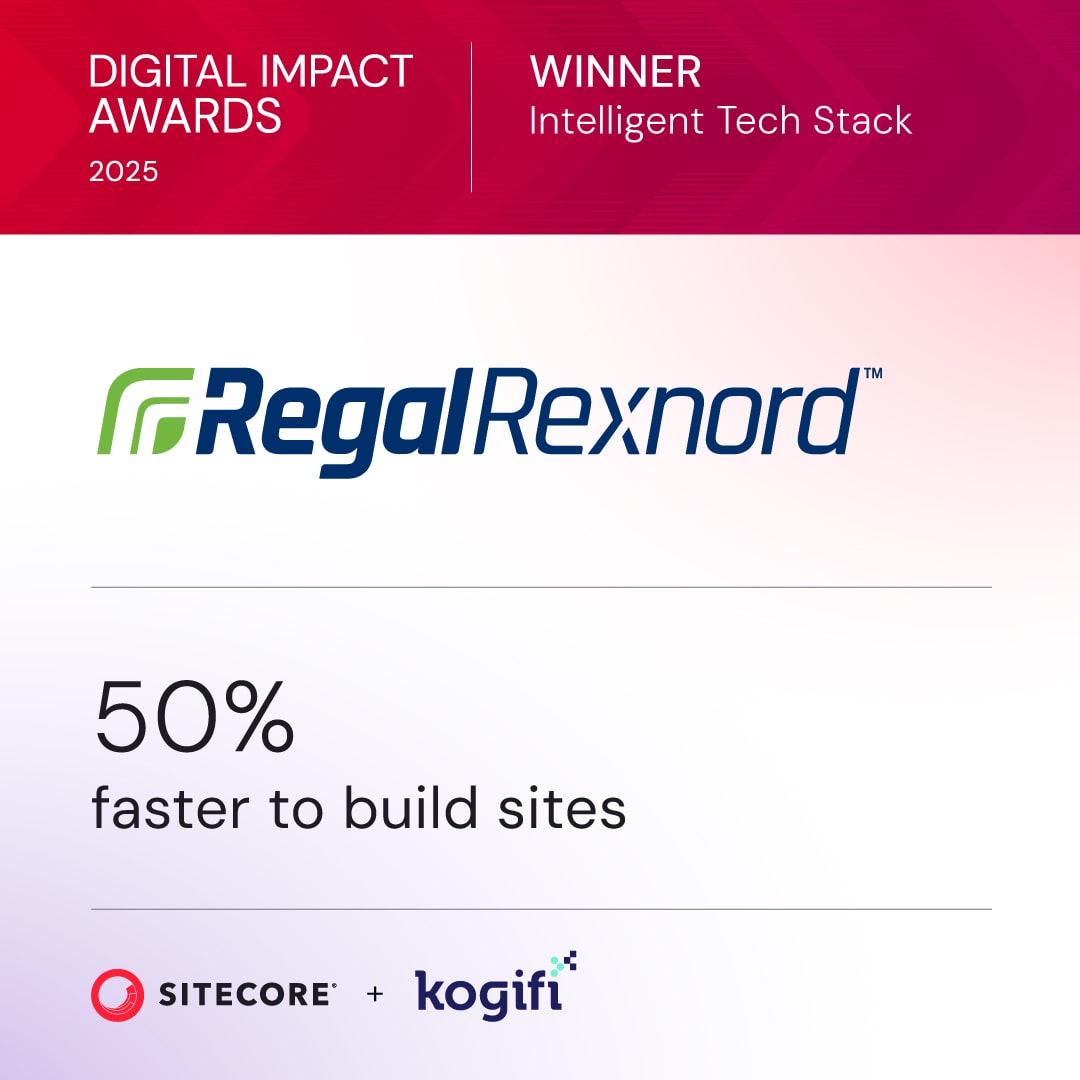An e-commerce Content Management System (CMS) is far more than just a product catalog—it's the operational heart of your entire digital storefront. Think of it as the engine that powers everything, seamlessly blending content, personalization, and transactions into a single, cohesive customer experience. This system is the foundation for every interaction, from the moment a customer discovers your brand to the final click of the purchase button.
Why Your CMS Is Your E-Commerce Engine
Choosing an e-commerce CMS is one of the most critical business decisions you'll make. It’s less like picking a piece of software and more like designing the blueprint for your entire digital business. A basic platform might let you list products and take payments, but a true e-commerce engine empowers you to build relationships, tell compelling brand stories, and create buying journeys that feel effortless.
Today’s shoppers expect more than a simple transaction. They want rich, helpful content that guides their decisions, personalized offers that reflect their interests, and a consistent experience whether they're on a laptop, a mobile app, or a social media feed. This is where a powerful CMS shines, transforming a simple online store into an immersive brand destination.
The Core Components of a Commerce Engine
A robust CMS orchestrates several key functions that work in concert to drive sales and build loyalty. These aren't separate, siloed tools; they are interconnected systems that create a fluid customer journey.
- Content Management: This goes way beyond product descriptions. We're talking about blog posts, buying guides, videos, and user-generated reviews—all the content that builds trust and establishes your authority.
- Personalization and AI: A modern CMS uses data to understand individual customer behavior. It then delivers targeted content and product recommendations that feel relevant, which in turn boosts conversion rates.
- Transaction Processing: This is the transactional backbone. It ensures a smooth, secure, and efficient checkout process from the moment an item is added to the cart until the confirmation email lands in their inbox.
The diagram below shows how these three pillars support the central CMS engine.
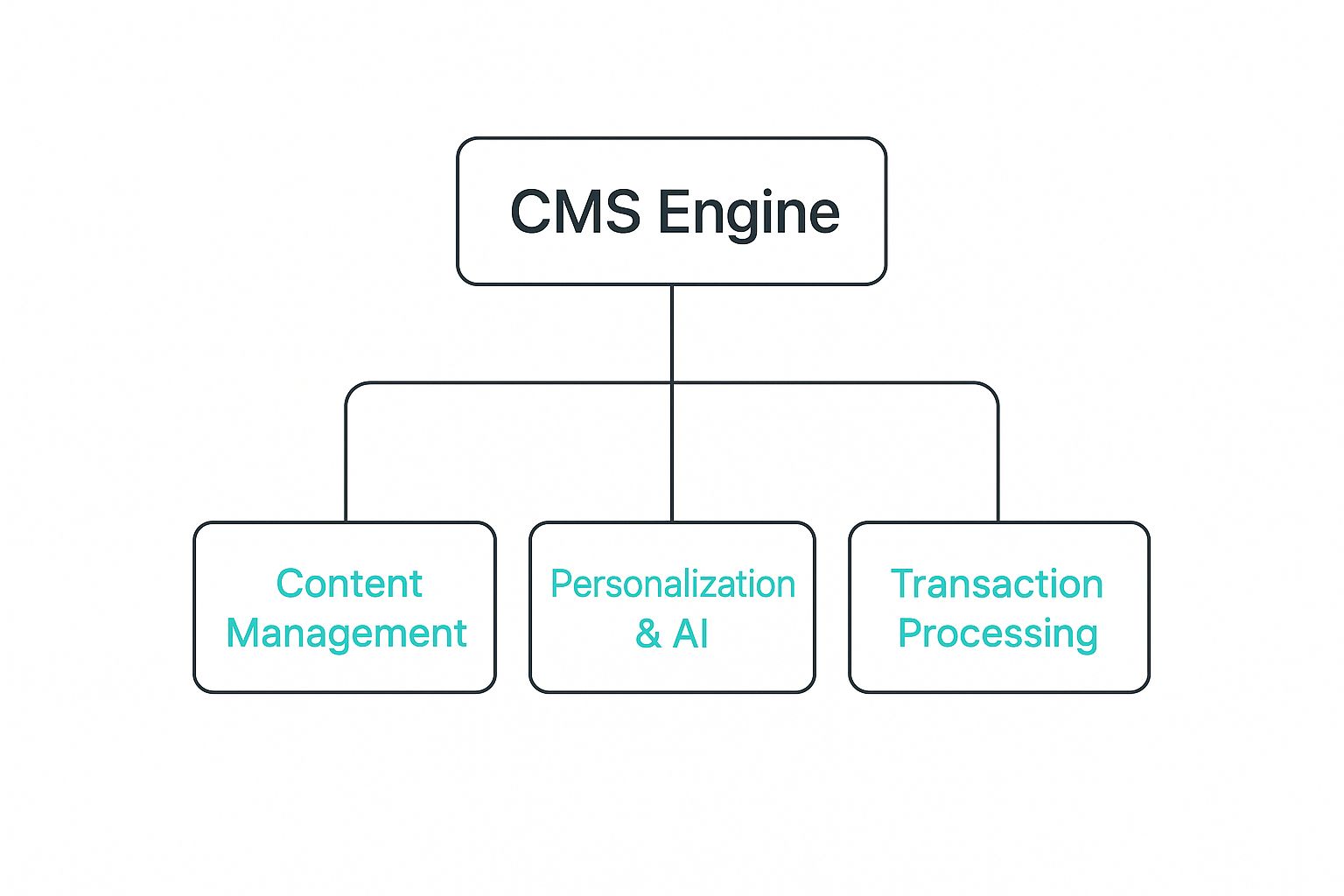
This visual makes it clear that a modern e-commerce content management system is an integrated platform, not just a random collection of features. Each component feeds into the others to create a digital storefront that is both holistic and effective.
A truly effective CMS for e-commerce blurs the line between content and commerce. A product page becomes an interactive guide, a blog post becomes a direct path to purchase, and every interaction is an opportunity to strengthen the customer relationship.
Platforms like Sitecore exemplify this integrated approach. They operate as a full-fledged Digital Experience Platform (DXP), where every single piece of content can be personalized and made shoppable on the spot. This ability to unite storytelling with sales is what separates the market leaders from the pack, turning your CMS from a simple tool into your most powerful asset for revenue growth.
Key Features of a Modern E-commerce CMS
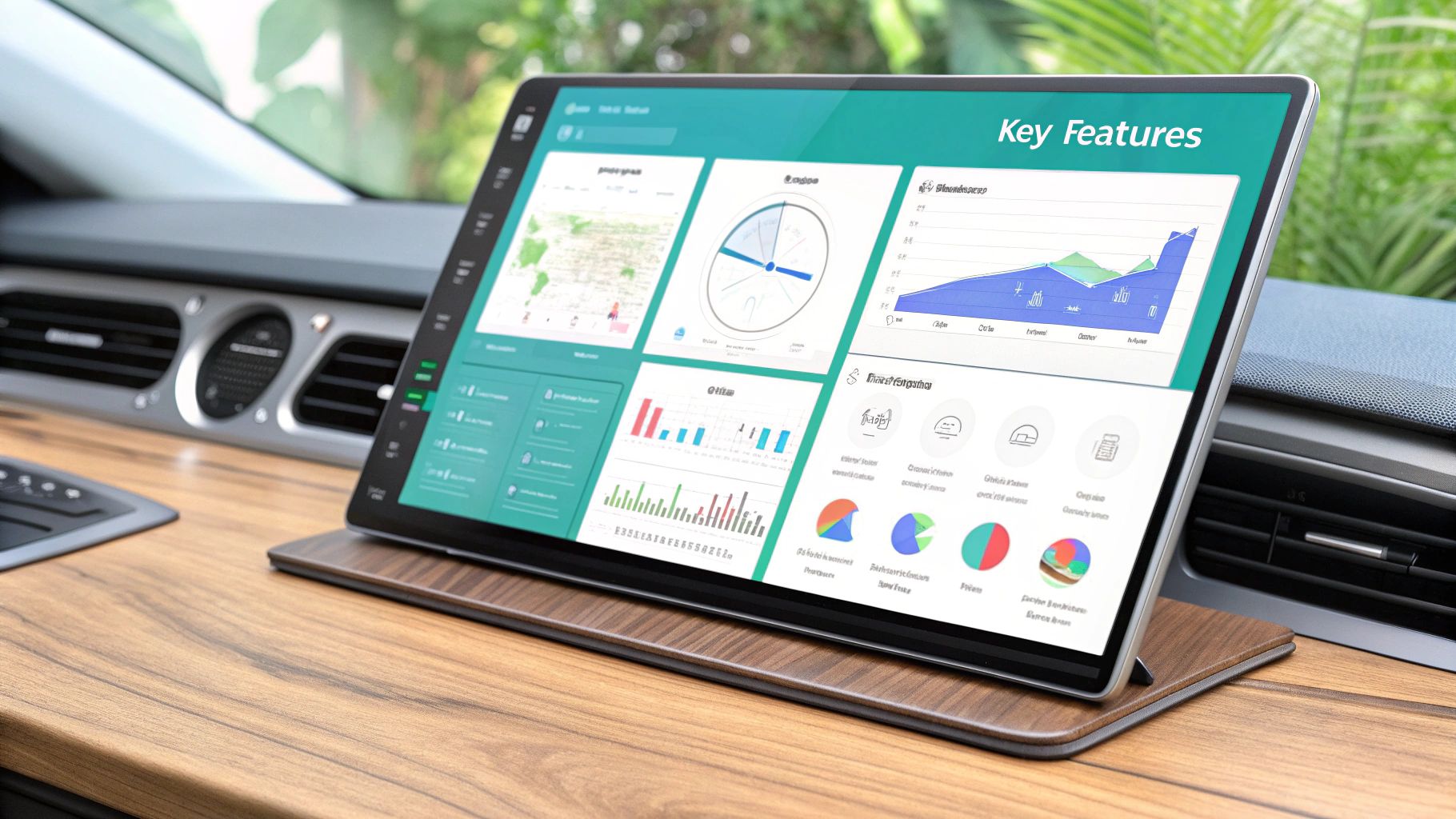
A top-tier e-commerce CMS is all about creating intelligent, personalized customer journeys. It's not a checklist of features; it's a strategic platform that drives real business results. The best systems blend content and commerce so seamlessly that customers don't even notice the technology—they just get a helpful, relevant experience.
This deep integration is what separates the leaders from the pack. They don't just show you products. They understand what you're looking for and serve up hyper-relevant content right when you need it. The Sitecore ecosystem is a perfect example of how this works in the real world.
AI-Driven Personalization Engines
The heart of a modern commerce experience is an AI-driven personalization engine. We’re not talking about just adding a first name to an email. This is about using real-time behavioral data to predict what a shopper wants next and delivering it on the spot.
This is exactly what Sitecore Personalize was built for. It captures every click, search, and interaction, feeding that data into its decisioning engine. The system then automatically tweaks website content, product recommendations, and special offers for each unique visitor.
A powerful personalization engine acts like an expert in-store associate for every single online customer. It anticipates needs, offers tailored advice, and guides them to the perfect purchase, which can dramatically increase conversion rates and average order value.
This capability turns a static product grid into a dynamic, one-to-one conversation. It’s the difference between a generic digital catalog and a curated shopping journey that builds lasting brand loyalty. Any serious e-commerce business today needs this level of real-time adaptation.
Integrated Customer Data Platforms
Personalization is only as good as the data powering it. That’s why an integrated Customer Data Platform (CDP) is non-negotiable. A CDP brings together customer data from every touchpoint—website, mobile app, CRM, even in-store systems—into a single, unified profile.
Sitecore CDP is a master at creating this complete view. It stitches together anonymous visitor data with known customer information, giving you a full picture of the customer journey. This allows marketers to understand behavior across different channels and over time, leading to much smarter engagement.
An integrated CDP gives you several key advantages:
- A Single Source of Truth: It breaks down data silos, so marketing, sales, and service teams are all working from the same complete customer profile.
- Enhanced Segmentation: It allows for the creation of incredibly specific audience segments based on complex behavioral and transactional data, making campaigns far more effective.
- Real-Time Data Activation: The data is instantly available to other tools, like Sitecore Personalize, to trigger experiences in the moment they matter most.
Without this unified data foundation, any attempt at personalization will only scratch the surface.
True Omnichannel Content Delivery
Today's customer journey isn't a straight line; it zig-zags between devices and channels. A modern CMS for e-commerce has to deliver content just as fluidly. This requires a flexible architecture—often a headless or hybrid model—that separates the content from its presentation.
This decoupling allows a single piece of content to be published anywhere—a website, a mobile app, a kiosk, or even a smartwatch—without having to rebuild it each time. If you want to dive deeper into the technical differences, our guide on headless CMS vs traditional CMS offers a great comparison. Sitecore's composable DXP is built on this principle, ensuring your brand message is consistent and optimized for every channel.
The table below breaks down how modern e-commerce CMS requirements have evolved beyond the capabilities of older, traditional systems.
Key Feature Breakdown for a Modern E-commerce CMS
This table contrasts traditional CMS features with the advanced capabilities required for a modern, personalized e-commerce experience, highlighting areas where platforms like Sitecore excel.
As you can see, the game has changed. A modern CMS isn't just a tool for managing a website; it's the central hub for orchestrating the entire customer experience across every touchpoint.
For internal or B2B commerce, tools like SharePoint also offer robust omnichannel features. Its strengths in document management and secure portals let businesses deliver personalized catalogs and ordering experiences to partners and employees across various devices, ensuring consistency in complex transactions.
Unlocking Agility with a Composable DXP
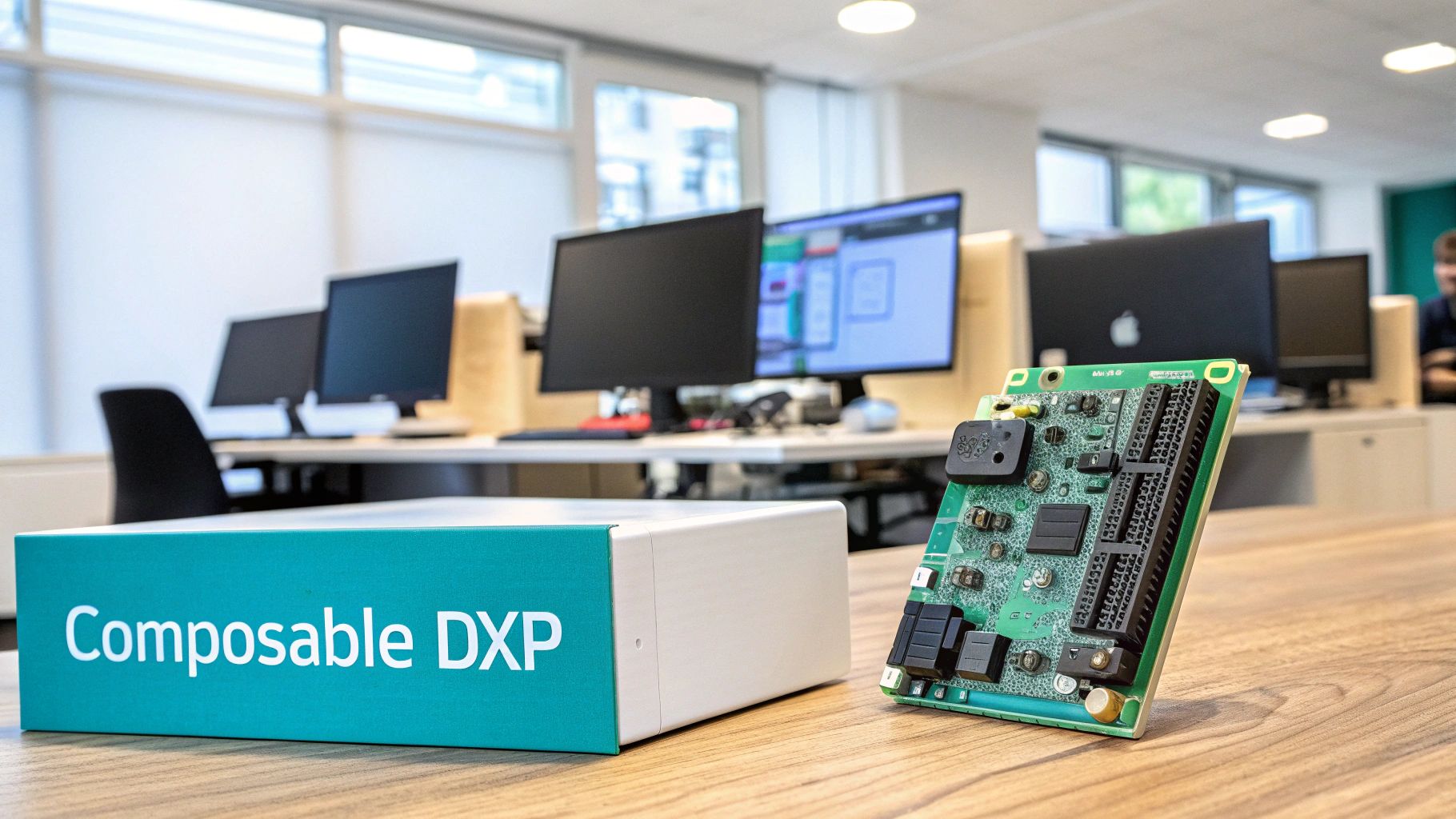
The days of the rigid, all-in-one CMS are numbered. Today's market leaders are moving to a much more flexible and powerful model: the composable Digital Experience Platform (DXP). This approach completely changes how businesses build and evolve their digital commerce operations.
Think of it like this: a monolithic system is a fixed-menu restaurant, where you get what's on offer. A composable DXP, on the other hand, is a master chef's kitchen stocked with specialized, best-of-breed tools. You get to pick and choose the perfect solution for each job—content, search, commerce, personalization—instead of being stuck with a single vendor's limitations. This is what modern agility is all about.
With this model, you can build a technology stack that's truly your own and ready for whatever comes next. For any business serious about creating unique customer experiences and reacting to market shifts in real-time, this is no longer just a nice-to-have; it's a competitive must.
Building with Sitecore's Composable Portfolio
Sitecore has gone all-in on the composable philosophy, offering a suite of powerful, API-first products that you can assemble to create a world-class e-commerce engine. Each piece is a powerhouse in its own right, designed to integrate seamlessly while delivering top-tier performance.
This architecture is built on the principles of MACH (Microservices, API-first, Cloud-native, Headless). Each service runs independently, talks to others through APIs, and is built for the cloud. This structure is what gives it the incredible speed and flexibility that older, monolithic platforms just can't keep up with. If you want to dig deeper into the concept, we have a great overview of what is composable commerce in our dedicated guide.
Let’s break down the key building blocks in Sitecore's ecosystem:
Sitecore XM Cloud: This is the heart of your content operations. As a cloud-native, headless CMS, it separates your content from its presentation. That means you can push brand stories and product details to any channel you can think of, from a website to a mobile app or an in-store kiosk.
Sitecore OrderCloud: A truly headless commerce platform, OrderCloud is engineered for complex B2B, B2C, and B2X scenarios. Its API-first design lets you build literally any commerce experience you can dream up without being boxed in by a rigid front-end.
Sitecore Search: This AI-powered tool delivers incredibly relevant, personalized search results and product recommendations. It goes way beyond simple keyword matching to actually understand what your user is looking for, which dramatically improves product discovery and sends conversion rates soaring.
These components lock together to form a cohesive, powerful CMS for e commerce. You get the freedom to innovate on the customer-facing front end while knowing you have a rock-solid, scalable back-end infrastructure supporting you.
The SharePoint Connection for Internal Commerce
While Sitecore is a beast at customer-facing experiences, the composable mindset doesn't stop there. It extends to internal and B2B operations, too. This is where a platform like SharePoint can be integrated to handle specific enterprise needs, like secure document management, version control, and workflow automation for complex B2B ordering portals.
A composable architecture isn't just about the customer experience; it's about operational excellence. By integrating specialized tools like SharePoint for B2B portals or partner extranets, you can build a comprehensive digital ecosystem that serves every part of your business.
For example, a global manufacturer could use SharePoint to manage detailed product specs, compliance documents, and partner contracts. That information can then be seamlessly pulled into an OrderCloud-powered portal, creating a secure and efficient ordering experience for distributors without ever compromising the integrity of the core data.
This ability to "compose" solutions with best-of-breed tools is the ultimate expression of business agility. It lets you launch new features faster, tailor experiences with precision, and adapt to whatever the market throws at you—all without being held back by a single, clunky system. Your tech stack becomes a dynamic asset that grows right alongside your business goals.
Using SharePoint for B2B and Internal Commerce

While platforms like Sitecore master the art of the public-facing, customer-first journey, the world of B2B and internal commerce plays by a completely different set of rules. We’re not talking about impulse buys here; we’re talking about transactions built on relationships, contracts, and complex approval chains.
This is where Microsoft SharePoint steps in as a surprisingly powerful, and often overlooked, commerce platform.
SharePoint’s real strength isn't in flashy product carousels but in creating secure, process-driven environments. It shines when building robust B2B ordering portals, exclusive partner extranets, and streamlined internal procurement systems. It just so happens that the platform’s built-in capabilities make it a natural fit for these exact scenarios.
Think about a global manufacturing firm. Its distributors scattered across the world don't need a public storefront. What they need is a secure, centralized hub to do business—and SharePoint provides the perfect foundation.
The Power of Granular Security and Permissions
The absolute number one requirement for any B2B portal is ironclad security. You have to be certain that a distributor in Germany sees only their specific contract pricing and product catalog, which will be completely different from what a partner in Japan sees.
This is where SharePoint’s exceptionally deep and flexible permission model becomes a game-changer. You can lock things down at multiple levels:
- Site Level: Granting access to the entire partner portal.
- Library Level: Restricting access to specific document libraries, like contracts or marketing materials.
- Item Level: Securing individual items, such as a single order form or a sensitive product spec sheet.
This granularity is everything. It allows a business to build one centralized portal that delivers a highly personalized and secure experience for each partner, killing any risk of exposing sensitive pricing or product info. This foundational security is a key reason so many organizations build their B2B operations on the platform.
You can dive deeper into this in our complete guide to building powerful SharePoint solutions.
Workflow Automation for Complex Transactions
B2B orders are rarely a simple “add to cart, click checkout” affair. They’re often tangled in multi-stage approvals, budget checks, and compliance reviews. This is another area where SharePoint excels, thanks to its native workflow automation powered by Power Automate.
Think of SharePoint's workflow engine as the digital equivalent of an entire procurement department. It automatically routes orders for approval, notifies stakeholders at each stage, and creates a complete, auditable trail for every transaction.
Let’s walk through an example. A distributor places a bulk order through a custom SharePoint form. The system can then automatically kick off a workflow:
- Initial Submission: The order gets logged, and an automated notification is sent to the regional sales manager.
- Manager Review: The manager reviews the order details right inside SharePoint and approves or rejects it with a click.
- Finance Approval: If the order value is over a certain threshold, say $50,000, it’s automatically routed to the finance team for a final budget check.
- Order Fulfillment: Once all approvals are in, the order is pushed to the ERP system for fulfillment, and the distributor is notified of the status change.
This kind of automation cuts down manual work, slashes errors, and speeds up the entire order-to-cash cycle. By flawlessly handling these complex, business-critical processes, SharePoint proves its worth as a highly effective CMS for e commerce in the B2B and internal enterprise world, turning a simple intranet into a dynamic business tool.
Choosing the Right CMS for Your Business Goals
Picking the right e-commerce CMS isn't just a technical decision; it's a strategic one. You need to look inward at your company's long-term vision first. Think of the platform as a core part of your growth engine. If you choose poorly, it becomes a bottleneck. A little self-assessment upfront saves a world of headaches down the road.
The whole process boils down to a few honest questions. What's your real plan for scaling over the next five to ten years? How many different systems—like an ERP or CRM—absolutely must play nicely with your e-commerce setup? And, most importantly, what's the total cost you can realistically stomach over the long haul? The answers will light the way.
There's no denying the massive footprint of CMS platforms. By 2025, they're expected to power roughly 68.7% of all websites, and over 28% of the top million sites are built for e-commerce. This isn't a niche market; it's the foundation of modern business. You can get a better sense of the scale by looking at these CMS statistics and market share insights.
Aligning Platform Capabilities with Business Scenarios
The best CMS for e commerce is simply the one that fits your business model and future plans like a glove. There’s no magic "best" platform—only the best fit for your specific goals. Let's look at two very different businesses to see what this means in practice.
Imagine a global consumer brand juggling multiple product lines across dozens of countries. Their needs are incredibly complex. This company requires:
- Multi-site and multi-language management to create localized shopping experiences from one central hub.
- Advanced personalization to serve up custom content and promotions based on customer data and behavior.
- Robust integration capabilities to connect with a tangled web of existing systems, from inventory and logistics to finance.
For a company like this, a Digital Experience Platform (DXP) like Sitecore is the obvious answer. Its powerful multi-site architecture and AI-driven personalization tools were built for exactly this kind of complexity. Sitecore gives the global brand team control over consistency while empowering regional marketers to launch localized campaigns—a balancing act that simpler platforms just can't handle.
When SharePoint is the Smarter Choice
Now, let's flip the script. Picture a large manufacturing company whose main goal is to make B2B sales cycles smoother and more efficient. They aren't focused on splashy public-facing marketing; their world is all about operational excellence and helping their partners succeed. Their priorities look very different:
- Secure, permission-based access for hundreds of distributors, each needing their own unique pricing and product catalogs.
- Automated workflow management to handle complex, multi-step approvals for massive orders.
- Seamless document integration to tie technical specs, contracts, and compliance docs directly into the ordering process.
In this scenario, SharePoint shines. Its core strengths in security, document management, and workflow automation are a perfect match for the intricate demands of B2B e-commerce. Building a secure B2B portal on SharePoint leverages a platform the company already knows and trusts, offering an efficient and cost-effective solution without the overkill of a full-blown DXP.
The most critical part of the selection process is honestly assessing your core business drivers. Are you in the business of creating deeply engaging, personalized customer journeys, or are you focused on optimizing complex, process-driven transactions? Your answer will point you directly to the right technology.
Ultimately, getting this alignment right is what separates success from failure. Whether you choose Sitecore for its customer experience muscle or SharePoint for its operational strength, you’re building a digital commerce engine that’s a strategic asset, not just another piece of software.
Future-Proofing Your Digital Commerce Strategy
Picking a CMS for e-commerce isn’t just about what you need today. It's about making a bet on your future. The digital world is always in motion, and tomorrow's trends will demand a lot more flexibility and smarts from your tech stack. The platform you choose now determines whether you’ll be leading the pack or just trying to keep up.
This isn’t just about selling things online. It's about building experiences that are ready for whatever comes next. Think about the rise of AI in product discovery, where tools like Sitecore Search do more than just match keywords—they actually anticipate what a shopper wants. That shift creates a more natural, conversational journey that doesn't just increase conversions but builds real loyalty.
Embracing Next-Generation Channels
The next wave of commerce is already forming on channels we're just starting to figure out, from augmented reality (AR) try-on apps to shopping on IoT-connected devices. A traditional, all-in-one CMS just can't push content out to these new frontiers. This is exactly where a headless, composable DXP becomes a must-have.
Sitecore's architecture was built for this reality. By separating the content back end from the customer-facing front end, it frees you up to design and deliver experiences on any screen or device imaginable. That headless capability is your ticket to true omnichannel innovation, making sure your brand shows up wherever your customers are.
A future-proof strategy views the CMS not as a website manager, but as the central hub for creating the next generation of omnichannel customer experiences. It is the foundation for building a lasting competitive advantage.
The Evolving CMS Landscape
The market itself is telling a clear story. Businesses are increasingly moving towards more sophisticated, managed solutions that can handle the complexity of modern digital ecosystems. This shift makes one thing clear: adaptability is the name of the game.
Ultimately, a flexible DXP like Sitecore gives you the strategic toolkit you need to win. When you pair it with a process-driven powerhouse like SharePoint for B2B operations, you’re not just building a website. You’re building a resilient, scalable, and intelligent digital commerce engine that can evolve right alongside technology and your customers' expectations, cementing your place as a leader for years to come.
Got Questions? We've Got Answers
Stepping into the world of e-commerce platforms can feel overwhelming. Let’s clear up a few common questions, especially when it comes to powerful, enterprise-level tools like Sitecore and specialized setups using SharePoint.
When Is Sitecore the Right Choice for E Commerce?
You’ll want to reach for Sitecore when your business lives and breathes personalized, content-heavy customer experiences. If your roadmap includes managing a family of brands or rolling out regional sites from one central hub, you need a CMS for e commerce that’s built for that kind of sophistication and scale.
It’s the go-to for enterprises that need to plug into complex back-end systems like ERPs and use rich customer data to power their marketing automation. Think of Sitecore as an investment in building lasting customer relationships and carving out a real competitive edge.
Can SharePoint Function as a True E Commerce Platform?
Absolutely, but it shines in very specific arenas. SharePoint is a powerhouse for B2B e-commerce portals, internal stores for employees, or procurement sites for partners.
Its real strength is in its ironclad security, document management, and workflow automation. That makes it the perfect choice for handling complex B2B contracts, custom catalogs for different business customers, and tangled approval chains. It’s not built for your average high-volume online store, but for business-to-business transactions, it’s a seriously formidable tool.
What Is the Biggest Mistake to Avoid When Choosing a CMS?
The single biggest mistake is picking a CMS that only solves today's problems while completely ignoring where your business is headed tomorrow. Too many companies get locked into a platform that feels great right now but simply can't grow or change with them.
This kind of short-sightedness almost always leads to a painful and expensive re-platforming project a few years down the line. You have to look beyond the current feature list and really dig into the platform’s architectural flexibility, its ability to scale, and how well it plays with other systems.
A composable DXP approach, which you’ll find in leading platforms like Sitecore, is your best defense against this common trap. It ensures your technology stack can evolve right alongside your business, rather than holding it back.
At Kogifi, we don't just implement platforms; we build powerful digital experiences that drive e-commerce success. Discover how our expertise can transform your business.






















